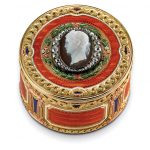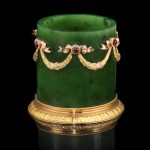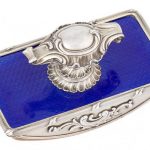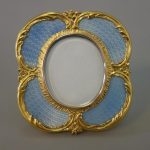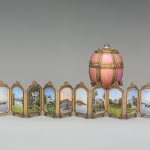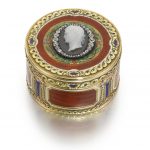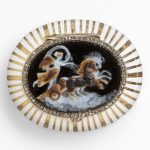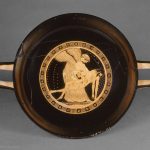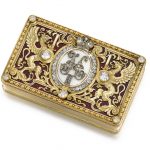Michael Evlampievich Perkhin (aka Michael Perchin) (1860-1903) was born in Okulovskaya in Olonets Governorate (now Republic of Karelia) and died in St. Petersburg. He was one of the most important Fabergé workmasters along with Henrik Wigström. Perchin became the leading workmaster in the House of Fabergé in 1886 and supervised production of the eggs until his death in 1903. The eggs he was responsible for were marked with his initials.
A Three-Colour Gold, Hardstone and Guilloché Enamel Box Marked Fabergé, with the workmaster’s mark of Michael Perchin, St Petersburg, circa 1890, scratched inventory number 45171 Circular, the sides enamelled with rectangular panels of translucent orange over a wavy guilloché ground within white enamel borders, alternating with lozenges of translucent blue enamel, the hinged cover set with an oval sardonyx cameo, finely carved with a bust of an emperor, possibly Alexander I, surrounded by graduated diamonds, all within bands of ribbon-tied laurels, chased flower-heads and guilloché enamel, the base also enamelled in translucent red, marked on bezel 2¼ in. (5.7 cm.) diameter
Sold for GBP 91,250 at Christies in 2010
A gold mounted, jewelled and nephrite miniature vase Fabergé workmaster Michael Perchin, St Petersburg, circa 1890 the cylindrical body applied with garnet-set ribbon-tied varicolour gold swags, upon spreading gadrooned base, 56 standard height: 4.8cm (1 1/2in).
Sold for £8,750 inc. premium at Bonhams in 2016
Fabergé Silver-Gilt and Guilloché Enamel Desk Blotter Workmaster Michael Perchin, St. Petersburg, before 1899 The rounded rectangular panel enameled in translucent royal blue over a wavy engine-turned ground, within a reeded and scrolled foliate border, with a silver rocaille handle, the silver blotter ends with foliate and C-scroll mounts. Length 3 3/4 inches (9.53 cm).
Good condition overall, enamel with very light surface scratches silver with light wear to gilding, minor surface scratches and light bruises, felt on the blotter has been replaced
Sold for $11,250 (includes buyer’s premium) at Doyle New York in 2018
A Faberge Russian guilloche enamel photograph frame, St Petersburg, pre – 1899. Head workmaster Michael Perchin. 14K yellow gold quatrefoil shaped frame, having a scrolling motif, alternating with budding flowers and surrounding four panels of robin’s egg blue guilloche enamel. The scrolling formed easel strut having the Cyrillic mark of Faberge. The edge of the frame and the easel strut having the 56 assay mark (corresponding to approximately 14K gold) and the city’s coat of arms of crossed anchors and scepter. The edge of the frame and the easel also stamped with head workmaster’s initials of Michael Perchin in Cyrillic. There are 8 gold screws attaching the back cover. Beveled oval glass insert, 1-7/8″ x 1-5/8″. The frame measures 3.25″ x 3″.
Sold for $9,000 at Klein James in 2018
Danish Palaces Egg Workmaster: Mikhail Evlampievich Perkhin (Russian, 1860–1903) Artist: Miniatures by Konstantin Yakovlevich Krijitski (died 1911)
Medium:Green, rose, and quatre-couleur gold, guilloché enamel, star sapphire, cabochon emerald, rose-cut diamond nacre, crystal crimson silk velvet
Czar Alexander presented this egg to his wife, Maria Feodorovna, on Easter 1890. The egg is extraordinary in its conception and technical virtuosity. It possesses one of the most sophisticated palettes of all the imperial Easter eggs. Divided into twelve sections in opalescent pink enamel, it opens on a hinge to reveal its surprise—a folding ten-panel gold screen in a crimson velvet pocket. Resting on Greek-key feet, the screen bears ten miniatures of the empress’s favorite Danish and Russian retreats. A nostalgic reminder of her home country, the egg accompanied her on her travels.
Reference: The Metropolitan Museum of Art
A Fabergé jewelled gold, enamel and hardstone box, workmaster Michael Perchin, St Petersburg, circa 1890 circular, the surfaces enamelled with panels of translucent reddish orange over banded wavy engine-turning within opaque white lines, the chased two-colour gold swirling acanthus borders and pilasters part-enamelled in royal blue, the lid centred with a carved agate cameo of Agrippa within rose- and circular-cut diamonds and a green laurel frame bound with orange ribbons, struck with workmaster’s initials and Fabergé in Cyrillic, 56 standard, scratched inventory number 45171 diameter 5.7cm, 2 1/4 in.
PROVENANCE Christie’s London, 8 June 2010, lot 155
Sold for 93,750 GBP at Sothebys in 2017
Oval gold bonbonnière, with bands of white enamel and gold, the hinged lid with a layered agate cameo carved with Aurora in her chariot within rose-cut diamond border. The cameo is 19th century in date.
The strong design of this bonbonnière is original. Some of Fabergé’s boxes are clearly indebted to eighteenth-century century prototypes, such as the Rococo or Neo-classicism. The cameo shows Neo-classical influence, as does the oval shape, but the rounded sides and rayed decoration in enamel are a late nineteenth-century development. Mikhail Perkhin, whose mark is struck on the inside of the box, was Fabergé’s head workmaster from 1886 until his death in 1903.
Reference: © Victoria and Albert Museum
